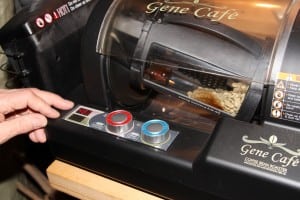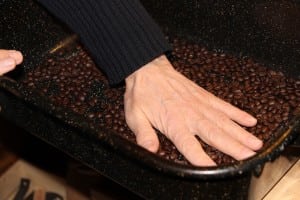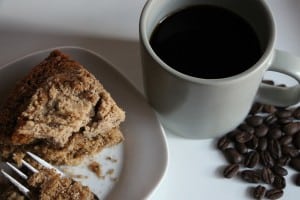1 part chaos, 2 parts calm
By Mary Ann Ebner
With his standard limit of one daily cup, Charles Day would rather skip coffee than drink it stale. The Cold Spring resident has tasted his way to faultless flavor not simply by sipping through a procession of espressos or lattes but by perfecting beans before the first pour.
Day started home-roasting coffee beans soon after he and his wife, Susan Wallach, relocated from his native England to Brooklyn.
“Susan’s sister’s husband got me interested in roasting 15 years ago,” Day said. “He presented us a roaster as a gift.”
The gift served them well but met its retirement. Now on his third roaster, Day, who moved to Cold Spring 11 years ago, uses a Gene Café CBR Model 101, made in Korea.
“It’s been very impressive,” Day said as he prepared to roast a batch of Sumatra Wahana Rasuna Honey beans. “You can get one for a few hundred dollars but this one was a little over 500 bucks.”
The roasting area doesn’t require much space. The roaster sits close to a basement wall with a window used for ventilation. Before Day begins the process, which is a full-on sensory engagement, he scans the raw beans and runs his hands through the tray to check texture and look for imperfections.
“Broken beans can lodge themselves into the little holes in the roaster and can burn,” Day said. “Then you get a bad batch.”
He experiments with beans of various origins to make a balanced cup, purchasing from green coffee suppliers, including Roastmasters.com in Connecticut and Sweet Maria’s in Oakland, California. Even the slightest change in roasting time can alter the profile of a batch as the process transforms the green coffee into powerfully aromatic brown beans.
Susan appreciates his darker range of coffees as well as an often-present warm aroma — roasty and earthy — wafting through the house. “He and I like different coffees,” she explains, so the aroma is constantly changing.
Anyone who has savored a custom cup of the family’s coffee (full disclosure: I enjoyed every drop) will never willingly return to mass-produced beans.
Day says coffee’s distinct smoky scent takes him back to his youth in Rochester, Kent. Though tea was rather important, the smell of fragrant coffee reminds him of his teen years. “I used to change buses for school and where I changed buses there was a little store, a coffee and tea store, with a roaster,” he said. “That’s where I used to smell it.”
Tea still matters to Day but since moving to the U.S., he drinks more coffee. He’s been mostly vegan for three years, but emphasizes that “mostly” keeps him eligible for an occasional diversion with his coffee. “Susan makes a coffee icing on a chocolate cake,” he said. “So sometimes, yes, I’m mostly vegan.”
Day recently conducted a roasting demonstration at Wave Hill, a public garden and cultural center in the Bronx, where he works as the Ruth Rea Howell horticultural interpreter. As a member of Cold Spring’s Tree Advisory Board, he pays precise attention to details in professional and personal endeavors.

In his roasting log, Day keeps a record of procedures, including dates, temperatures, roasting time, stages of the roast and overall taste. The roaster combines heat with an agitation method as well as a collection process to retrieve the chaff, the light husks that come off beans as they expand during the roast. When the roasting begins, an audible crack sounds, similar to the sound of popcorn popping.
“One of the most important points of having the log is it tells me details of cracks,” he said. “Until that first crack, the coffee is not roasted. Immediately after that first crack is finished, the coffee can be withdrawn as a very light roast. You can continue to the second crack for a darker roast and beyond that, it can be roasted to black and very dark.”
With this particular batch, Day estimated he would roast for 17 minutes with a peak temperature of 482 degrees Fahrenheit. As the first crack sounded, he dropped the temperature to 460 degrees and checked the remaining time for roasting: 6.5 minutes. Once the batch reached the desired stage, he recorded the time, temperature and crack notations and transferred the beans from the rotating chamber to the cooling tray.

After cooling, Day stores his roasts in airtight jars and labels them. Within a week, he fires up his roaster to replenish the family supply for grinding, brewing and relishing, favoring the freshness over store-bought beans, which may age for months.
“The general recommendation is not to use the beans for 24 to 48 hours,” he said. “It’s best after 48 and we tend to make it by the cup with a filter throughout the week. After a week it’s still perfectly drinkable but it’s not quite as flavorful.”
If you’re not a home-roasting candidate, search for a respected roaster. Day enjoys the beans roasted in small batches by Coffee Labs Roasters in Tarrytown and sold at Bank Square Coffeehouse in Beacon. “When I roast it, I guarantee that it’s fresh,” he says, “but there’s a good reason why there are professional roasters.”
Coffee Cake
½ pound (two sticks) salted butter
3 cups flour
2¼ cups sugar
2¼ teaspoons baking soda
3 tablespoons ground cinnamon
3 tablespoons freshly ground coffee (medium grind)
1½ cups buttermilk
2 eggs, lightly beaten
Mix flour, sugar, baking soda, cinnamon and ground coffee. Add butter. Blend gently two minutes until crumbly texture forms. Reserve ¾ cup of dry mixture and set aside. Add buttermilk and mix thoroughly. Gently fold in beaten eggs.
Pour into a greased and floured 8-inch springform pan. Sprinkle reserved dry mixture over top of batter. Bake at 350 degrees for 50 minutes. Cool, remove from pan and serve with coffee.

Having sampled many of Charlie Day’s cups of coffee in his years to researching the best coffee to drink, I can say this is a good article about a man who knows his coffee.
Many thanks to Charlie for sharing his coffee wisdom!